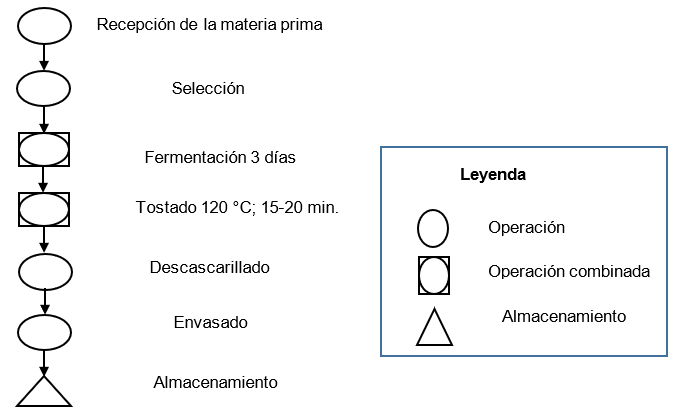Antioxidant activity and phenolic content of cocoa husk variety CCN-51 induced during fermentation with efficient microorganisms
DOI:
https://doi.org/10.56926/repia.v4i2.97Keywords:
cocoa, fermentation, secondary metabolitesAbstract
The utilization of cocoa husks is fundamental to the value chain. This research aimed to evaluate the antioxidant activity and phenolic content of CCN-51 cocoa husks fermented with efficient microorganisms. A completely randomized experimental design was used with six treatments and three replicates, considering two types of microorganisms (Biol Albiobatch and ME-1), two extracts (banana and apple), and two study areas (Manabí and Esmeraldas). pH, ash content, and antioxidant capacity were analyzed using the ABTS and DPPH methods, with readings obtained from a UV-visible spectrophotometer. The results showed no significant differences in pH, while ash content was highest in treatment T4 (11.71%) and lowest in T10 (9.50%). Antioxidant capacity was highest in T5, with values of 54.53 ± 5.17 in ABTS (µmol TE/g) and 44.70 ± 4 in DPPH (µmol TE/g). Although there were no differences in phenolic content, treatment T3 had the highest flavonoid levels (5.39 ± 0.20 mg CE/g). It is concluded that cocoa husk flour possesses antioxidant and nutritional properties, with potential applications in both the food and non-food industries.
Downloads
References
Aguilar, H. (2016). Manual para la evaluación de la calidad del grano de cacao. Fhia, 1(1), 10–11. https://fhia.org.hn/wp-content/uploads/Manual_para_la_Evaluacion_de_la_Calidad_del_Grano_de_Cacao.pdf
Alcívar, K., Quezada, J., Garzón, J., Barrezueta, S., & Carvaja, H. (2021). Análisis económico de la exportación del cacao en el Ecuador durante el periodo 2014 – 2019. Polo Del Conocimiento, 6(3), 2430–2444. https://polodelconocimiento.com/ojs/index.php/es/article/view/2522
Aldas, J., Otero, V., Revilla, K., Carrillo, M., & Sánchez, D. (2023). Incidencia del tostado sobre las características fisicoquímicas y alcaloides de la cascarilla de cacao (Theobroma cacao) y su efecto en las propiedades organolépticas de una infusión. Agroindustrial Science, 13(1), 15–21. https://doi.org/10.17268/agroind.sci.2023.01.02 DOI: https://doi.org/10.17268/agroind.sci.2023.01.02
Arévalo, E., Obando Cerpa, M. E., Zúñiga Cernades, L. B., Hernández Arévalo, V. B., & He, Z. (2016). Metales pesados en suelos de plantaciones de cacao (Theobroma cacao L.) en tres regiones del Perú. Ecología Aplicada, 15(2), 81. https://doi.org/10.21704/rea.v15i2.747 DOI: https://doi.org/10.21704/rea.v15i2.747
Chancay, L. F., Delgado Demera, M., & Salas Macías, C. A. (2022). Cadmio en el cultivo de cacao (Theobroma cacao L.) y sus efectos ambientales. La Técnica: Revista de Las Agrociencias. ISSN 2477-8982, 91. https://doi.org/10.33936/la_tecnica.v0i0.4324 DOI: https://doi.org/10.33936/la_tecnica.v0i0.4324
Dubón, A. (2016). Protocolo para el beneficiado y calidad del cacao. Fhia, 18. https://fhia.org.hn/wp-content/uploads/Protocolo-para-el-beneficiado-y-calidad-del-cacao.pdf
Fernández, V., Hernández Varela, D. J., & Sulbarán Rodríguez, B. (2016). Caracterización físico-química y actividad antioxidante de frutos de mango (Mangifera indica cv. Tommy Atkins. Revista de la Facultad de Agronomía de la Universidad del Zulia, 33(May), 216–231. https://produccioncientificaluz.org/index.php/agronomia/article/view/27199
Freire, D., & Díaz, D. (2022). Método de fermentación y secado para el beneficio de la obtención del chocolate blanco a partir del cacao criollo (Theobroma cacao L.), ecuatoriano. Revista Universidad y Sociedad, 14(2), 323–329. https://rus.ucf.edu.cu/index.php/rus/article/view/2788
Hidalgo, F. (2020). Cacao y campesinos: Experiencias de producción e investigación.
Jara, J., & Rodríguez, L. (2022). Importancia de los dispositivos usados en la fermentación de Cacao (Theobroma cacao L.). Agrotec. Amaz., 2(1), 1–10. https://doi.org/10.51252/raa.v2i1.281 DOI: https://doi.org/10.51252/raa.v2i1.281
Li, M., Wang, M., Hu, S., Sun, J., Zhu, M., Ni, Y., & Wang, J. (2022). Advanced coatings with antioxidant and antibacterial activity for Kumquat preservation. Foods, 11(15), 1–9. https://doi.org/10.3390/foods11152363 DOI: https://doi.org/10.3390/foods11152363
Machado, L., Ordoñez, C., Sánchez, Y., Cruz, L., & Suárez, J. (2018). Organoleptic quality assessment of Theobroma cacao L. in cocoa farms in northern Huila, Colombia. Acta Agronómica, 67(1), 46–52. https://doi.org/10.15446/acag.v67n1.66572 DOI: https://doi.org/10.15446/acag.v67n1.66572
Ordoñez, S., Vera, J., & Tigselema, S. (2019). Cascarilla de cacao (Theobroma cacao l.) De líneas híbridas para la elaboración de rehiletes de chocolate. Revista Universidad y Sociedad, 11(2). http://scielo.sld.cu/scielo.php?script=sci_arttext&pid=S2218-36202019000200136
Pallares, A., Estupiñán, M., Perea Villamil, J., & López Giraldo, L. J. (2016). Impacto de la fermentación y secado sobre el contenido de polifenoles y capacidad antioxidante del clon de cacao CCN-51. Revista ION, 29(2), 7–21. https://doi.org/10.18273/revion.v29n2-2016001 DOI: https://doi.org/10.18273/revion.v29n2-2016001
Perea, J., Cadena, T., & Herrera, J. (2009). El cacao y sus productos como fuente de antioxidantes: Efecto del procesamiento. Revista de la Universidad Industrial de Santander. Salud, 41(2), 128–134. https://www.redalyc.org/pdf/3438/343835695003.pdf
Piedrahita, C. E., Gallego Díaz, J. D., Herrera Castañeda, J. M., & Tomayo Sánchez, C. A. (2018). Implementación de buenas prácticas agrícolas en cultivos de cacao Theobroma cacao L. como estrategia para prevenir la presencia de cadmio en la cadena cacaotera. In: L. D. Gómez Cruz (Ed.), Sennova (Vol. 1).
Reyes, Y. C., Vergara, I., Torres, O. E., Díaz, M., & González, E. E. (2016). Contaminación por metales Pesados: implicaciones en salud, ambiente y seguridad alimentaria. Ingeniería, Investigación y Desarrollo, 16(2), 66–77. https://doi.org/10.19053/1900771x.v16.n2.2016.5447 DOI: https://doi.org/10.19053/1900771X.v16.n2.2016.5447
Rodríguez, N. D., Chávez, B., Gómez, I., Vásquez, M. S. & Estrada, P. (2022). El cultivo del cacao, sus características y su asociación con microorganismos durante la fermentación. Alianzas y tendencias BUAP, 7(25), 36–51. http://doi.org/10.5281/zenodo.6326782
Sánchez, M., Vargas, Y., & Burbano, R. (2019). Evaluation of the cocoa bean (Theobroma cacao L.), using two fermentators, Orellana and Sucumbios Provinces, Ecuador. International Journal of Engineering Research & Technology, 8(7), 278–283. https://repositorio.iniap.gob.ec/server/api/core/bitstreams/3e800315-bd34-4754-bef8-6183561ba054/content
Schwan, R., Pereira, G., & Fleet, G. (2024). Microbial activities during cocoa fermentation. Cocoa and Coffee Fermentations, September, 129–192. https://www.researchgate.net/publication/285267847_Microbial_activities_during_cocoa_fermentation
Torres, J., & Pérez, R. (2023). Caracterización de los residuos de cacao generados con potencial valor, para su uso en la industria alimentaria, en el cantón Santo Domingo, provincia de Santo Domingo de los Tsáchilas.

Downloads
Published
How to Cite
Issue
Section
License
Copyright (c) 2025 Frank Guillermo Intriago-Flor, María Johana Zambrano-Vera, Jessenia Jomira Ramos-Pino, Kerly Estefanía Alvarado-Vásquez

This work is licensed under a Creative Commons Attribution 4.0 International License.
Authors retain their rights:
a. The authors retain the intellectual property rights (copyright) of the published works, assigning to the journal the right of first publication.
b. Authors retain their trademark and patent rights, and also on any process or procedure described in the article.
c. Authors retain the right to share, copy, distribute, perform and publicly communicate the article published in REPIA (e.g., place it in an institutional repository or publish it in a book), with an acknowledgement of its initial publication in REPIA.
d. Authors retain the right to make a subsequent publication of their work, to use the article or any part of it (e.g., a compilation of their work, notes for conferences, theses, or for a book), provided they indicate the source of publication (authors of the work, journal, volume, number, and date).







